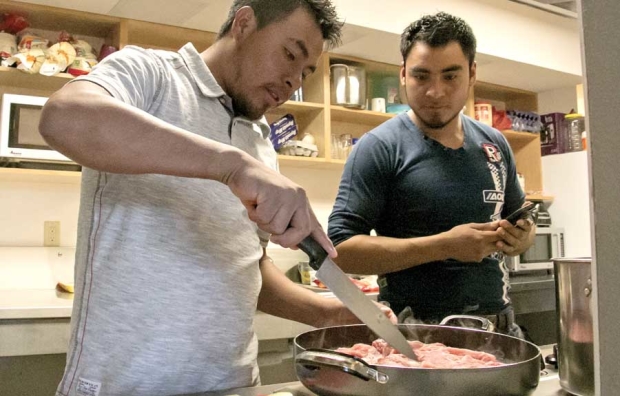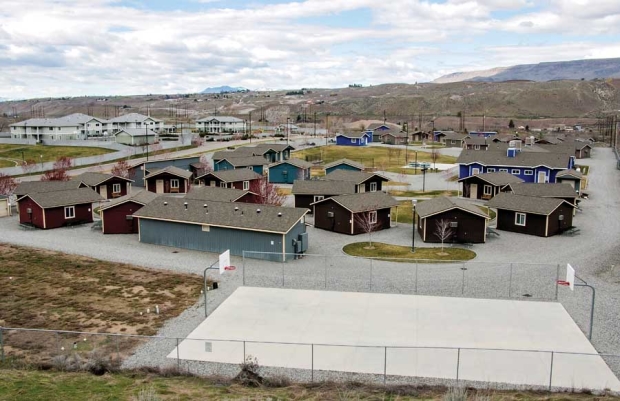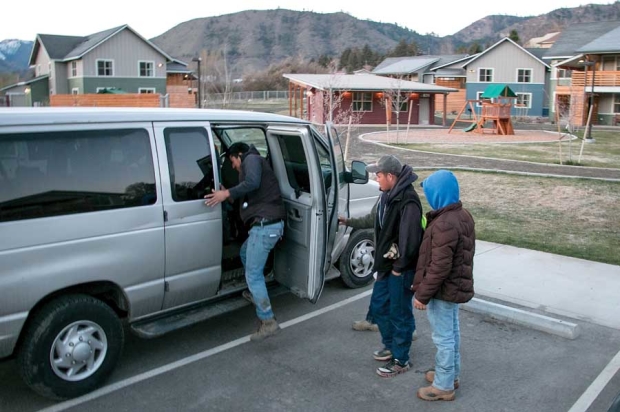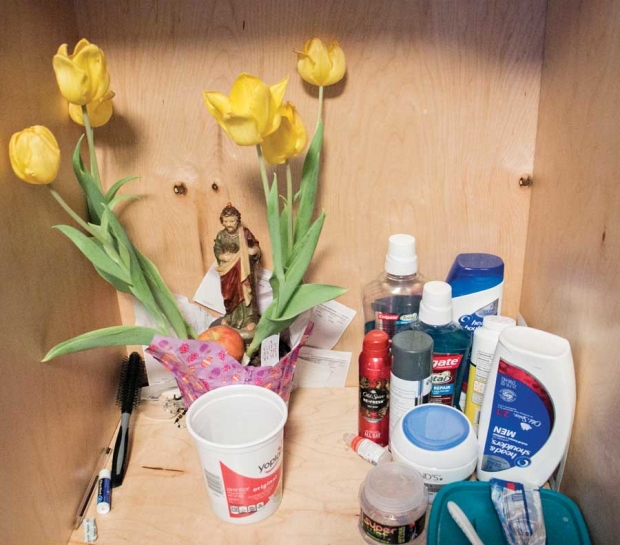
Brothers Daniel, left, and Alberto Morales cook dinner at the Brender Creek seasonal farm worker housing facility in Cashmere, Washington, on Monday, March 28, 2016. (Ross Courtney/Good Fruit Grower)
When it came their turn to cook after a long day of pruning pear trees, Daniel and Alberto Morales sought a little help from home.
Using a photo of a handwritten family recipe texted to them by their aunt, the two brothers whipped up chicken and pork adobo to feed themselves and their fellow H-2A workers living at the Brender Creek seasonal agricultural labor facility in Cashmere, Washington.
Cooking is not normally their strong suit, but they do what they have to do 3,000 miles and a 50-hour bus ride from their home in Cuilapan, a mountain village in the Mexican state of Guerrero.
“We make an effort,” Daniel said through a translator. “There’s no choice.”

Alberto Morales checks a photo of a hand-written adobo recipe texted to him by his aunt in Mexico. (Ross Courtney/Good Fruit Grower)
Whether from Mexico, Thailand, Jamaica or migrating through the United States, farm workers need a place to live when working at an orchard or vineyard.
Seasonal farm worker housing has turned into one of the most expensive and crucial facets growers must address to make sure they have enough hands to prune, thin and pick their fruit every year.
To meet that need, growers can — and do — invest millions in their own housing units. In the past five years, growers have spent more than $100 million on housing, said Dan Fazio, executive director of the Olympia-based farm labor organization WAFLA.
But not all can afford it, have the land for it or care to manage their own facilities.
“Housing development is a big job and it takes your focus away from farming,” said Mike Gempler, executive director of the Washington Growers League, a Yakima nonprofit that focuses on labor issues.
So, growers rent from the local market or book through a facility operated by the Growers League, WAFLA or the Catholic Charities Housing Services.
Catholic Charities, also based in Yakima, offers seasonal farm worker housing in 17 Central Washington communities.
Meanwhile, WAFLA — formerly known as the Washington Farm Labor Association — has a 96-bed facility in Mesa and has applied for funding for a 150-bed facility in Omak it hopes to open in 2018.

The Sage Bluff seasonal farmworker housing facility, shown on Monday, March 28, 2016, in Malaga, Washington, was built in 2009. (Ross Courtney/Good Fruit Grower)
The Growers League, which owns Brender Creek and the Sage Bluff complex about 45 minutes away in Malaga, will break ground this spring on a 144-bed facility in Mattawa, a small Grant County community with a surging fruit and wine grape industry.
The Washington Department of Commerce awarded the Growers League a $3 million grant in December, and the facility should open for its first tenants in 2017.
The Growers League also is applying for a grant to build another 200 beds in Mattawa on the same grounds, with the goal of opening that section in 2018.
Mattawa has one of Washington’s highest seasonal farm labor housing needs. People often live 10 to 15 to a house. Landlords divide trailer homes in half for make-shift duplexes. “For Rent” signs rarely last a day.
And the crunch is starting earlier each year, said Silvia Barajas, a Mattawa city councilwoman who has owned a bakery and restaurant with her husband for 20 years.
“I usually see that in cherry season, but now it’s March and I’m starting to see that,” said Barajas, once herself a seasonal farm laborer.
Farm worker life

H-2A guest worker tenants of the Brender Creek seasonal farm worker housing facility in Cashmere, Washington, board a van early Tuesday morning, March 29, 2016, headed toward a day of pruning pears near Wenatchee. Whether growers hire domestic migrants or H-2A foreign guest workers, temporary housing needs are becoming more pronounced and more tightly regulated. (Ross Courtney/Good Fruit Grower)
Back in Cashmere, life at Brender Creek is usually boring, with “de descanso” and “comiendo” (resting and eating) the most common activities.
One resident runs several times a week and asked for permission to store a weight set in his room, but he’s the exception.
“A lot of them, when they get off work, they just want to go to bed,” said Cody Chrismer, the on-site manager who lives at Brender Creek with his family of four.
But the grounds have their lively moments, too. Cooking competitions break out, residents fish and hike on their days off and kick a soccer ball around.
One summer, a Norteño band was among the group of workers, and music from their rehearsals drifted late into the evening, eliciting complaints from neighbors, Chrismer said. But the music was good, he admitted.
At Sage Bluff, televised Mexican League soccer games pack the dining hall. Brender Creek has no TV, one of the residents’ first complaints when comparing the two locations.

A shrine to St. Jude shares shelf space with mouthwash and shampoo in the room of Jose Herrera and Roberto Gonzalez on Monday, March 28, 2016, at the Brender Creek seasonal farm worker housing facility in Cashmere, Washington. Whether growers hire domestic migrants or H-2A foreign guest workers, temporary housing needs are becoming more pronounced and more tightly regulated. (Ross Courtney/Good Fruit Grower)
Generally speaking, residents favor units that allow as much privacy, cooking space and security for personal belongings as possible.
Managers sometimes respond to accusations of theft of food and pots and pans, prompting the Growers League to install refrigerators inside the bedrooms. Basketball courts and grassy areas for soccer are well used.
Opening date at both Growers League facilities varies year to year based on demand. Both accept walk-in traffic — individuals or families just looking for work — and reservations.
Walk-ins cost $8 per night per bed. Reserving beds, which employers often do, costs $9 per bed. Sage Bluff, built in 2007, sees about half of each.
Meanwhile, both foreign guest workers and domestic migrants stay in the temporary facilities.
The Morales brothers and their 17 fellow tenants arrived at Brender Creek in January and have a guest worker visa contract through October.
They’re saving their money to build houses, open businesses or expand their own subsistence corn and bean farms at home. Many call their families only once a week because their remote villages have only one phone, located at a pay-per-minute business.
“Honestly, we wish to be with our families,” said Jose Juan Barrios, a 37-year-old father of three from Aixcualco, Guerrero, Mexico. “But over there, there isn’t enough to succeed. We all leave our homes to have a better future.” •
– by Ross Courtney






Leave A Comment